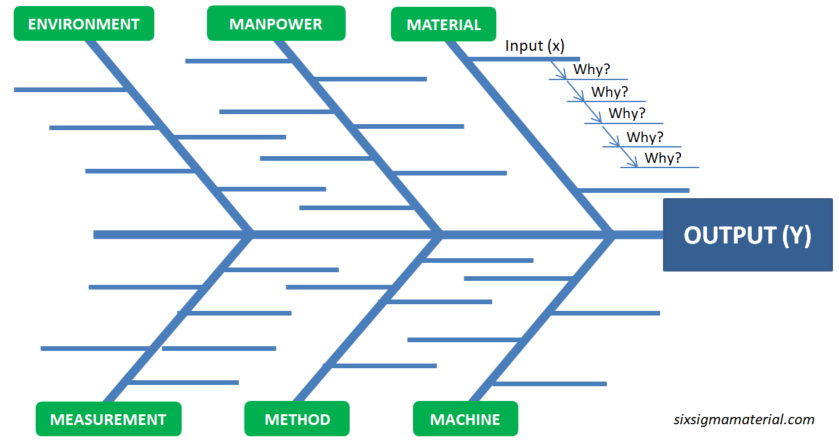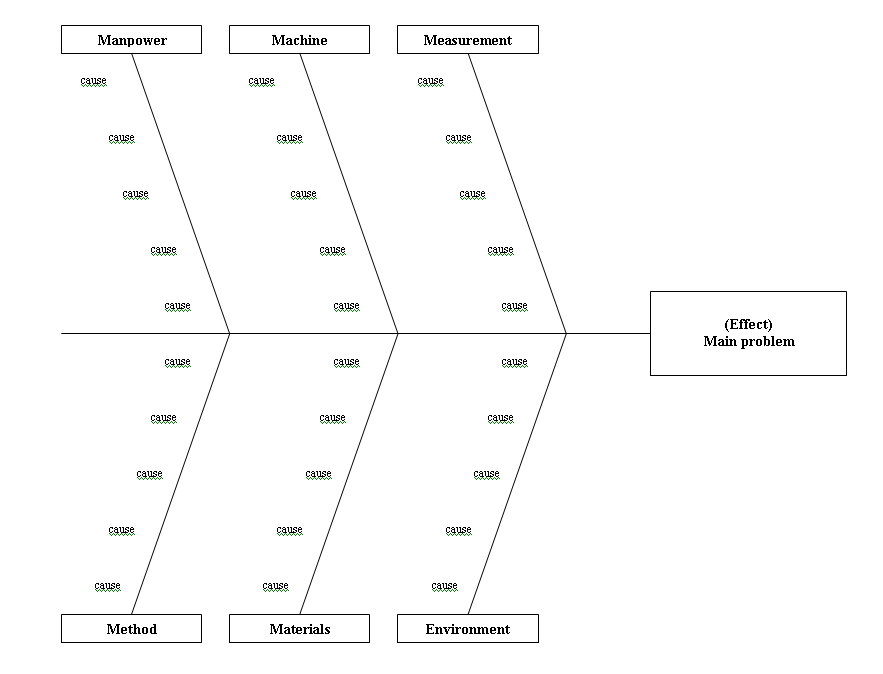Fishbone Diagram Is Used in Which Phase of Dmaic
An important tool used in the _____ phase of the DMAIC process is the fishbone or Ishikawa diagram. Usually is used during project analysis phase but not limited for that.

Fishbone Diagram Ishakawa Diagram Cause And Effect Diagram
This third article in a series explores the third step of DMAIC.

. A fishbone diagram is a visual way to look at cause and effect. Also see DMAIC OverviewParticularly DMAIC is a logical framework that helps you think through and plan. Tree Diagrams are used in the _____ phases of the Define Measure Analyze Improve and Control DMAIC cycle.
Ishikawa Diagram otherwise known as Fishbone diagram is one of the tools most commonly used by Quality Professionals. Only in-house auditors can perform quality audits. These elements can help describing areas that are causing or influencing malfunctioning effect.
Here are some screenshots from the training file Introduction general format and what the tool is used for. Analysis of Fishbone. This is a graphical demonstration of possible problem causes.
Diagrams of fish bones are used in analyze phase of the DMAIC Define Measure Analyze Improve and Control process. Check out DMAIC office example video. 2 Initiate the use of tools for monitoring process performance.
One of the principal tools in Six Sigma is the use of the DMAIC methodology. During which phase of the DMAIC process is the fishbone or Ishikawa diagram used. A Cause Effect or Fishbone Diagram is used in the Analyze phase in order to examine the relationship between.
Asked Aug 11 2017 in Business by tattoo_guy58. Six Sigma is a systematic problem solving approach that is centered around defects elimination and variation reduction which leads to process improvement. The DMAIC phases are as follows.
Choosing a Right Parametric Test. This diagram is also used together with a 5 why analysis used to drill down to the root cause of the problem from the defined causes. The purpose of this tool is to list down ALL the potential root causes leading to a problem.
A cause and effect diagram often called a fishbone diagram can help in brainstorming to identify possible causes of a problem and in sorting ideas into useful categories. It initiates the collection of the all root causes xs or inputs that contribute to the problem also. The Fishbone diagram is part of the _____ phase of the Define Measure Analyze Improve and Control DMAIC cycle.
This diagram is also complemented with why-why analysis. Cause and Effect Diagram Fish Bone Diagram Ishikawa Diagram. It takes its name from the fact that it resembles the shape of a fish skeleton.
Ishikaw a diagram also referred as fishbone diagram and cause-and-effect diagram is often used to identify possible causes of a problem. ANOVA fishbone diagram scatterplots and correlation analysis. This methodology is used for Lean Six Sigma type of problem-solving technique.
The Fishbone diagram is one of the seven quality control tools and is used in the analyze phase of the DMAIC Define measure analyze improve and control approach. This quality tool is often used during Analyze phase of lean six sigma DMAIC methodology application. Thus it is one of the important tools used for problem solving methods like DMAIC PDCA and many other projectsOther than that Ishikawa diagram is also used in New.
Tools in this phase of a project using Six Sigma. Overall construction the problem statement goes at the head of the fish and potential. It is a more structured approach than some other tools available for brainstorming causes.
Control Maintain the gains youve made with. It is the methodology used for Lean Six Sigma a problem-solving tool. Any misuse found should be identified and prioritized to improve.
Most commonly used during the Analyze phase of a DMAIC project a fishbone allows project teams to organize potential causes for problems and get at root causes. Which phase of the DMAIC process includes tools such as a project charter a description of customer requirements process. Select one answer only 1 A problem and its potential causes.
Also called an Ishikawa diagram or cause-and-effect diagram it can be created on paper or white board in a brainstorming session or via computer once the information is available. Fishbone diagrams are considered one of seven basic quality tools and are used in the analyze phase of Six Sigmas DMAIC define measure analyze improve control approach to problem-solving. In a DMAIC Six Sigma project this tool is used in the MEASURE phase.
Fish bone diagram strongly support brainstorming and discussions about a problem our effect. This is a visual tool used to brainstorm the probable causes for a particular effect to occur. Measure Assess the extent of the issue and quantify it with data.
Fishbone diagrams are also called a cause and effect diagram or Ishikawa diagram. Its shape has earned the nickname of the Fishbone Diagram. The DMAIC Analyze phase involves identifying and confirming potential root causes.
Effect or the problem is analogously captured as the head of the fish and thus the name. When creating a control plan you should consider which of the following items. Its a diagram that depicts the causes of an event and its commonly used in manufacturing and product development to depict the many.
This is one of the most commonly used tools of continuous improvement programs and is one of the 7 Basic Quality Tools bundled together by Ishikawa. One of the seven essential quality tools used in manufacturing is the Ishikawa fishbone diagram. These are used in Six Sigmas DMAIC define measure analyze improve control problem-solving approachs analyze phase.
This free Fishbone Diagram training course provides you with the materials you need to share fishbone diagrams with other team members customers and suppliers. Analyze Use a data-driven approach to find the root cause of the problem. Target of this phase is to determine the KPIVs that are making the major effect on Y also known as output.
3 Establish baseline measures. The most common tool used in this phase is the fishbone diagram also called the Ishikawa graph. Answered Aug 11 2017 by.
Define Define the problem that needs solving. Improve Put changes into place that eliminate the root cause. 4 Implement the solution.
2 The problem and its solutions. Choosing a Right Control Chart. Fishbone diagrams are used in the Analyze phase of the DMAIC define measure analyze improve and control.



Belum ada Komentar untuk "Fishbone Diagram Is Used in Which Phase of Dmaic"
Posting Komentar